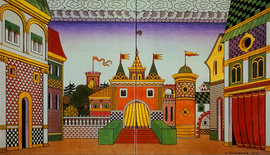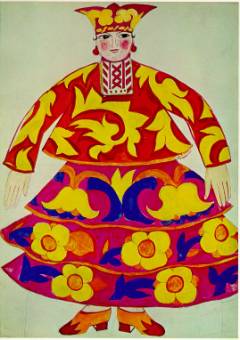|
HISTORY
- The libretto by Vladimir Bel'sky was adapted from the famous folk tale by Alexander Pushkin, which in turn
was based on 'The House of the Weathercock' and 'Legend of the Arabian Astrologer' from The Alhambra by Washington
Irving.
- The composer supported the political uprisings in 1905, defending the freedom of his students' musical
expression in the St. Petersburg Conservatory. Facing government suppression, Rimsky-Korsakov resigned his post, which
then led to great interest from the press and musical and intellectual circles. The government yielded and was forced
to recognize the Conservatory.
- The work satirized the disastrous tsarist regime and was censored for its portrayal of a lazy aristocrat's
interest in expansionism. This closely resembled the recent events in Russia that pertained to the Russo-Japanese War.
Also, King Dodon's remark, near the end, that 'blood at a wedding' is a bad omen was held to refer to the accidental crushing
to death of nearly a thousand people at Nicholas II's coronation. With some alterations to the libretto, however, Rimsky-Korsakov
kept a reference near the end to 'a new dawn... without the Tsar.'
- Although he never was able to see a realization of his opera on stage, Rimsky-Korsakov was able to perform
the excerpts 'Introduction,' 'Wedding Procession,' and the Queen of Shemakha's aria, 'Hymn to the Sun' on the concert platform.
- The opera was completed in 1907 but premiered posthumously on September 24, 1909 at the Solodovnikov Theater
in Moscow. Later it was staged at the opera in Paris and London in 1914 under the title Le Coq d'Or.
Now it is almost exclusively performed in its native tongue, Russian.
PLOT
- The Golden Cockerel is a dramatized fable structered in a prologue, three acts, and an epilogue. It
is set in an unspecified time in the Thrice-Tenth Kingdom, a far-off place in Russian fairy-tales.
- Prologue: The Astrologer, the opera's framing character and implied narrator, appears before the curtain to warn the audience
that he is about to tell a cautionary tale. This would later influence the structure and narrative ideas in Stravinsky's
Oedipus Rex.
- Act I: The Kingdom of Dodon is threatened by an enemny and no one knows how to defend it. The Astrologer appears
with a Golden Cockerel, who will crow whenever there is danger. In appreciation, the King offers to give the Astrologer
whatever he wishes. The Astrologer says he will claim his reward later, but would like the promise in writing, to make
it 'lawful.' The King indignantly refuses (an obvious statement on the Tsarist regime in Russia): "Lawful? What's
that? I never heard of such a thing. My whims and orders - that's the law around here." Soon the Cockerel
crows and Dodon marches off with his two sons and their armies.
- Act II: Dodon and his soldiers rest in a mountain pass. The two princes and many soldiers have been killed.
The beautiful Queen of Shemakha appears and performs her famous aria, the 'Hymn to the Sun.' She claims responsibilty
for the deaths of the princes. The Queen of Shemakha then performs an enchanting dance with veils for
the King (which is later seen in Richard Strauss' Salome) and agrees to marry him. One is left to question
if the Queen of Shemakha represents youth or beauty or evil.
- Act III: The townspeople gather in front of the King's palace, awaiting his return. The King arrives with the Queen
of Shemakha and the Wedding Procession commences. At this moment, the Astrologer demands to have his wish fulfilled:
he wants the Queen! King Dodon refuses and kills the Astrologer. The Golden Cockerel then attacks the King and
pecks him to death, and then vanishes with the Queen of Shemakha.
- Epilogue: The Astrologer reappears before the curtain, reassuring the audience that what they have seen is only a fairy
tale and therefore they should not be upset. He leaves with the fact that only he and the Queen of Shemakha were real
people - all the rest were a dream.
MUSICAL CHARACTERISTICS
SOUND:
- Rimsky-Korsakov combines Russian nationalism and the music of the Russian people with traditional classical formal and
melodic structures. He evokes the young and vigorous folk spirit of the people by incorporating elements of the songs,
dances, and religious music of the people,ultimately creating novelty and freshness.
- Elements of traditional Russian folk melodies appear when the Queen of Shemakha forces King Dodon to sing her a love song
in Act II and also in the triumphant wedding procession and chorus.
- Orientalism is common. One can hear the typical Eastern melismas throughout the piece, especially in the Queen of
Shemakha's entrance aria, the 'Hymn to the Sun.' This virtuosic aria employs quick chromatic ascending and decending
runs (sometimes in retrogrades and inversions) and staccati.
- Orchestral tone painting is a prominent feature throughout his works. The brash opening timbre of The Golden
Cockerel displays the colors of lubki (pl. form of lubok). The lubki are a part of Russian folk arts and are derived
from oral and written folklore, and are characterized by simple and loud prints. The sets and costumes correspond with
the music to create a total musical and visual image of the folk tradition.
- He perceived colors associated with major keys: C - white; D - yellow; E flat - dark bluish-grey; E - sparkling sapphire;
F - green; G - right gold; A - rosy colored.
- Russian melodies appear when Rimsky-Korsakov combines chromaticism and diatonicism in the sleeping scene of Act I. The
lullaby occurs twice in the act: the first time, Tsar Dodon is sleeping in his palace under the comforting blessing of the
Cockerel. This blessing is orchestrally interpreted by the transformation of the Cockerel's sharp cry into a simple
tune. The music changes to the chromatic theme of the Queen of Shemakha as King Dodon begins to dream of a beautiful
woman. Her exoticism is reflected in the chromaticism and fully diminished seventh chords played by the orchestra. The
King wakes at the false alarm of an enemy attack, and his next dream combines the music of the Queen with the simplicity of
the Cockerel's blessing.
- Vocal choices: the role of the Astronomer is sung by a 'tenore altino,' who must reach a high E, and the lead female role,
the Queen of Shemakha, is sung by a coloratura soprano. The vocal parts reflect the bright and penetrating colors of
the lubki.
STYLE:
- Rimsky-Korsakov adopts Western techniques and employs the use of leitmotifs, which are first heard in the Cockerel's
opening theme. Some sonorities, like the Astologer's glockenspiel, function as 'leit-timbres.'
- The composer references his own work, The Tale of Tsar Saltan, which also uses an opening garish trumpet phrase
at the beginning of the opera.
- The orchestral 'tone painting' and orientalism feature prominently in his works, most notably in his famous Scheherazade,
Sadko, Antar, The Tale of Tsar Saltan, Easter Overture, and Capriccio español.
FORM:
- The adaptation of an existing famous text by Pushkin into a libretto parallels many operatic pieves that are based off
of national literature and oral tradition.
- Recurring harmonic devices, such as the juztaposition of the triads of D flat major and E major, are used throughout.

|
| Act III design by Ivan Bilibin for the original production in Moscow |

|
| The King in 'The Golden Cockerel' |
|

